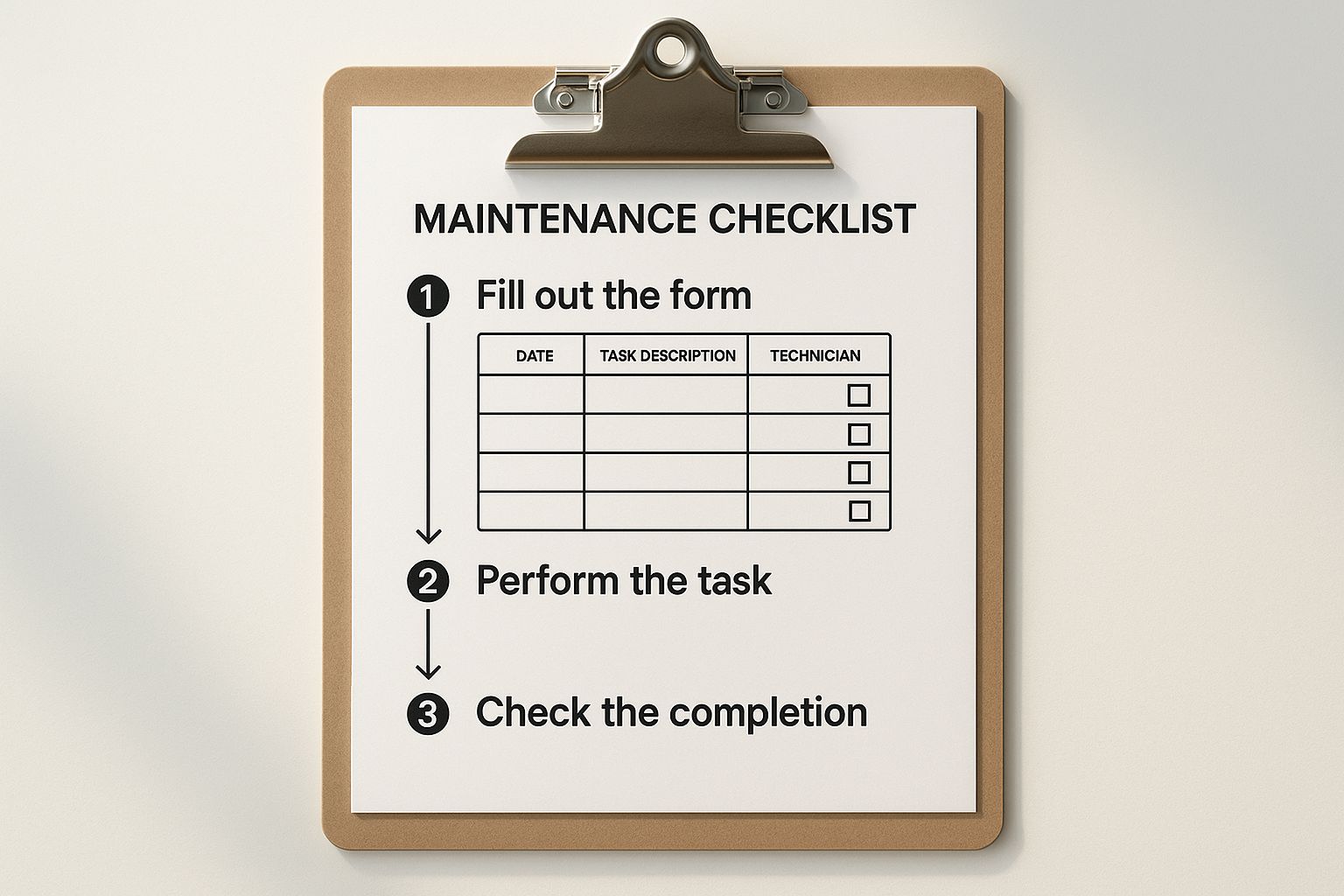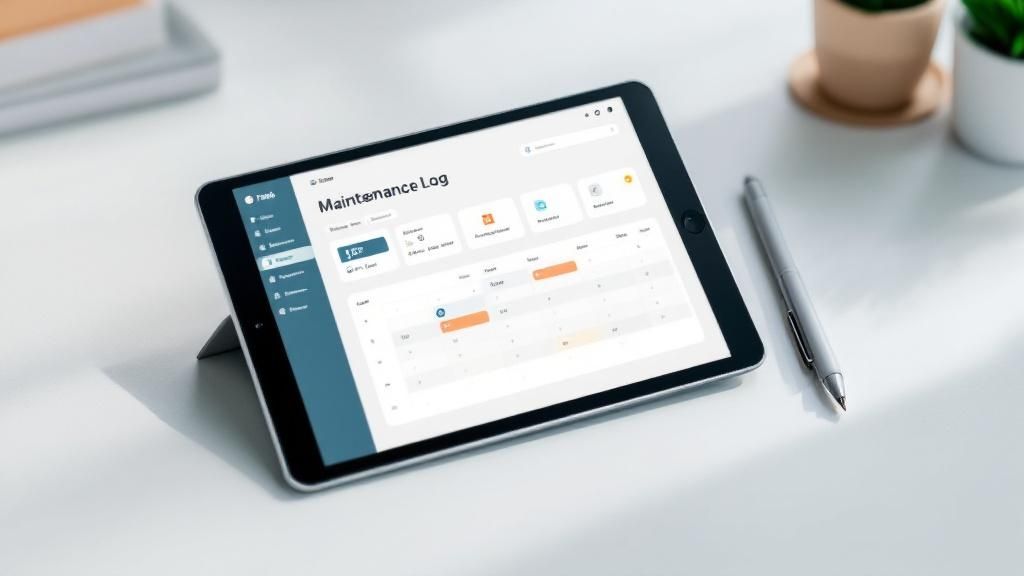An equipment maintenance log is the life story of your machinery. It’s a running record that documents every single service, repair, and inspection a piece of equipment goes through. But thinking of it as just paperwork is a huge mistake. These logs are the very bedrock of any solid maintenance strategy, giving you the hard data needed to stop breakdowns before they happen, get more years out of your assets, and make your entire operation run smoother.
Why Smart Maintenance Logs Are Your Secret Weapon

It’s time to move on from dusty binders and messy spreadsheets. A modern equipment maintenance log is a goldmine of data that can turn your maintenance department from a cost center into a real value-driver for the business. It’s what allows you to shift away from constantly putting out fires and toward a culture that anticipates problems before they bring everything to a halt.
When you keep these logs diligently, you build a complete history for every machine. This historical view is priceless. It lets you spot those nagging, recurring issues, see how different parts wear over time, and make smart, data-backed calls on whether to repair a machine one more time or finally replace it.
From Reactive Repairs to a Proactive Strategy
The real magic of a good maintenance log is how it transforms your team's approach. Instead of waiting for a critical asset to grind to a halt and then scrambling to get it back online, you can use the data from your logs to see what's coming. This proactive mindset pays off in some very real ways:
- Slash Unplanned Downtime: When you can spot potential failures early, you get to schedule the repair work during planned shutdowns. That means your operations keep humming along without interruption.
- Extend Asset Life: Regular, well-documented servicing keeps equipment running at its best. This reduces wear and tear on critical components and can help you put off massive replacement costs for years.
- Enhance Workplace Safety: There's no doubt about it—a well-maintained machine is a safer machine. Your logs become a clear audit trail, proving that all the necessary safety checks and repairs have been done right and on time.
- Improve Budget Forecasting: With a clear history of what you've spent on repairs and how often, you can predict future maintenance costs with surprising accuracy. No more budget surprises.
The core idea is simple: You can't manage what you don't measure. A detailed log provides the measurements you need to take control of your assets and your budget.
The Rise of Data-Driven Maintenance
The industry is making a hard shift toward making decisions based on data, and maintenance logs are right at the center of it all. By 2025, it's become standard practice to track key metrics like Mean Time to Repair (MTTR), asset uptime, and Planned Maintenance Percentage in real time. This allows managers to put resources where they're needed most, make repairs more efficient, and ensure maintenance work directly supports the company's biggest goals.
The principle of keeping detailed records isn't just for heavy machinery, either. Think about a car— understanding the importance of service history gives a potential buyer a clear picture of its health and true value, helping them avoid expensive problems down the road. The same logic applies to your multi-million dollar assets.
What Goes Into a Good Maintenance Log?
Think of your maintenance log as the complete biography of a piece of equipment, not just a simple form. Every single field you fill out adds a critical chapter to that story, providing the kind of context that’s priceless for future troubleshooting, budget planning, and even staying compliant. To build equipment maintenance logs that actually work for you, consistency in capturing the right information is everything.
It all starts with the absolute basics: what piece of equipment are we talking about? This sounds almost too simple to mention, but you'd be surprised how often inconsistent naming makes it impossible to track an asset's history. Every entry has to begin with unambiguous identification.
- Asset ID: A unique number or code—think asset tag—that points to one specific machine and nothing else.
- Asset Name: The everyday name for the equipment, like "Conveyor Belt #3."
- Location: Where to find it on the floor, such as "Warehouse B, Packing Line 2."
Get these wrong, and you could be reviewing the repair history for a completely different machine. That’s a recipe for confusion and wasted time.
Describing the Work That Was Done
Once you’ve tagged the right asset, the next step is to detail the "what" and "why" of the maintenance task. This is where your log transforms from a basic checklist into a goldmine of operational insight. Entries like "fixed machine" are completely useless. You need the specifics.
Let's say a conveyor belt grinds to a halt. A good log entry paints a full picture of the entire event.
Here’s how that looks in the real world:
- Reason for Maintenance: "Unplanned Downtime." This immediately tells you it was a reactive repair, not scheduled PM. Tracking this helps you see if your proactive maintenance is actually working.
- Work Description: "Motor seized, causing belt to stop. Found a failed bearing during inspection. Replaced bearing (Part #789-C), lubricated the full assembly, and ran a full functional test. Belt is now running at normal speed."
- Technician Name: "Sarah Jenkins." This adds accountability and gives everyone a point person if questions pop up later.
See the difference? A manager looking at this log a year from now knows exactly what part failed, what the fix was, and who to talk to about it. That's a story with a beginning, middle, and end.
Keeping Track of Time and Materials
The final, crucial pieces of the puzzle are the resources you poured into the job—both time and materials. This data is the key to calculating your true cost of maintenance and getting a handle on your parts inventory. A truly comprehensive equipment maintenance log has to track these elements with precision.
A maintenance log that doesn't track time and parts is missing half the story. It tells you what happened, but not what it cost your operation in downtime and resources.
Your log should always have fields for these essentials:
- Date and Start/End Times: You need the exact timestamp when work began and when it was completed. This is the foundation for calculating how long repairs actually take.
- Total Downtime: This is the total time the asset was out of commission. It’s often longer than the repair time itself, especially if you’re waiting on parts to arrive.
- Parts & Materials Used: List every single component, including part numbers and how many were used (e.g., "1x Bearing #789-C, 1 can Lubricant #L-45").
- Associated Costs: Log the cost of parts and any external labor you had to bring in.
When you fill out all these fields consistently, your equipment maintenance logs become an incredibly powerful database. You can start analyzing repair trends, tracking how quickly you burn through certain parts, and flagging the "lemon" assets that are draining your budget. This is how you start making decisions based on hard data, not just gut feelings.
Making the Switch to Digital Logs
Let's be honest: the idea of ditching those stacks of paper binders and moving to a digital system can feel like a massive project. But in my experience, it's one of the single most powerful upgrades you can make to your maintenance operation. Going digital with your equipment maintenance logs, typically through a Computerized Maintenance Management System (CMMS), isn't just about new software. It's a fundamental shift in how your team works, communicates, and ultimately, solves problems.
The initial steps—like getting years of paper records into a new system and training the team—can look intimidating. I've seen it firsthand. But the payoff comes much faster than you’d think. You'll almost immediately see a huge drop in time spent on administrative busywork, gain instant access to critical data from anywhere, and have automated reporting at your fingertips.
Building a Bulletproof Business Case
To get everyone on board, from the C-suite down to your newest technician, you need to talk about the clear wins—both financially and operationally. Start by putting a number on the time your crew currently sinks into paperwork. How many hours a week are lost just filling out forms by hand, digging through filing cabinets for old records, or manually compiling reports? A digital system automates all of that, freeing up your skilled techs to do what you hired them for: keeping the equipment running.
Then, talk about the cost of not having information on hand. When a critical machine goes down, a technician with a tablet can pull up its entire service history on the spot—every past repair, every part used, and even the original technical manual. This kind of access dramatically speeds up diagnostics and slashes downtime, which is a direct boost to your bottom line.
The core argument for switching is undeniable: Digital logs transform your maintenance history from a dusty archive into a dynamic, searchable database that actively helps you make faster, smarter decisions every single day.
Think about all the data points on a standard maintenance form. This image shows a pretty typical example.

When you capture all of this digitally, you can filter, analyze, and report on any of it in seconds. That’s the real game-changer.
Choosing the Right Tools for the Job
Not all digital systems are built the same, so it pays to be picky. As you start looking at software, focus on the features that will actually make a difference for your team on the floor.
- Mobile Access: Your technicians are rarely at a desk. Their tools need to be just as mobile. A solid mobile app that lets them log work, snap photos of issues, and access information right at the machine is non-negotiable.
- Customizable Forms: Your processes are unique to your operation. The software has to let you build your own digital checklists and log templates that mirror your established workflows. This ensures you don't lose any critical data during the switch.
- Seamless Integration: Look for a system that plays well with others. If it can connect to your inventory or accounting software, you’re on your way to creating a single, reliable source of information for the whole company.
This isn't just a niche trend. The 2025 State of Maintenance Report found that over 4,000 companies are now using digital asset management software to turn their maintenance data into a real competitive edge. They're using it to benchmark performance, fine-tune workflows, and see major improvements in both efficiency and safety. If you're curious, you can read the full State of Maintenance report to see exactly how they're doing it.
Here’s a pro tip for a smooth transition: start small with a pilot program. Pick a motivated group of technicians and one or two key pieces of equipment. Let them test drive the new system, give you honest feedback, and become your internal champions. Their success and enthusiasm will make a full, company-wide rollout much, much easier.
Turning Your Log Data into Predictive Insights
Think of your equipment maintenance logs as more than just a history book. They're actually a goldmine of data. When you learn how to read them correctly, you can start predicting equipment failures before they happen, effectively giving you a crystal ball for your operations. This is the leap from just logging what broke to actively forecasting what's going to break.
It all starts with digging into the data you’ve already collected. You're looking for patterns, even small ones. Maybe you spot that a certain hydraulic pump tends to give out every 8 to 10 months. Or perhaps you notice that one specific PM task is taking your technicians longer and longer to complete over the past year. These aren't just random occurrences; they're clues telling you it's time to adjust your strategy.
From Scheduled Fixes to Smart Interventions
This kind of analysis lets you break free from the old, rigid calendar schedules. Instead of servicing a machine every six months just because the calendar says so, you can switch to condition-based work. The machine's actual data—its performance, its history—triggers the maintenance. This is a much smarter way to work, saving you a ton of time and money by putting your team's efforts exactly where they're needed most.
By analyzing historical data from your equipment maintenance logs, you transform your strategy from reactive and scheduled to intelligent and predictive. This proactive stance is the key to minimizing downtime and extending the lifespan of your most critical assets.
This data-first approach is what modern maintenance is all about. The market for predictive maintenance, which is built on this very idea of detailed log analysis, is booming. It's projected to jump from around $4 billion in 2020 to an estimated $12 billion by 2025. That kind of growth tells you just how valuable this is. You can discover more insights about the predictive maintenance market to see the trend for yourself.
Integrating AI and Real-Time Monitoring
The next evolution is to pair your digital logs with today's technology. This is where tools like Industrial Internet of Things (IIoT) sensors and artificial intelligence (AI) come into the picture, adding a whole new layer of insight to your data.
Here’s how they fit in:
- IIoT Sensors: These are small devices you can attach to your equipment. They feed you a constant stream of real-time health data—things like vibration, temperature, and pressure.
- AI-Powered Analysis: An AI system, like Nora, can take all that live sensor data and compare it against your historical maintenance logs. It’s built to spot complex patterns that would be nearly impossible for a person to see, leading to surprisingly accurate failure predictions.
Imagine this scenario: an AI flags a tiny shift in a motor's vibration. It then checks your log history and sees that this specific pattern, on this model, has led to bearing failure before. The system then alerts you that there's an 85% chance of failure within the next 72 hours. That's a game-changer. It gives your team a window to schedule the repair on your own terms, avoiding a sudden, expensive breakdown in the middle of a production run.
Best Practices for High-Quality Data Entry

Let's be blunt: your equipment maintenance logs are only as good as the information you put into them. All the fancy analytics and predictive modeling in the world won't help if your team's entries are a mess of inconsistent, incomplete, or just plain wrong data. Garbage in, garbage out—it's a cliché for a reason.
The real secret to effective logging is shifting your team's mindset. Data entry isn't just a chore to be rushed at the end of a job; it's a fundamental part of the maintenance work itself.
Your goal should be to build a clean, reliable dataset where every task is logged the same way, by every technician, every single time. This uniformity is what allows you to spot trends, generate trustworthy reports, and eventually get ahead of problems. It all starts with setting some clear ground rules.
Establish Clear Data Entry Rules
You can't expect your team to be consistent if you haven't told them what "good" looks like. The first step is to get rid of the guesswork by creating a standardized format for every log entry.
- Agree on Common Language: Are you doing a "PM," "Preventive Maintenance," or a "Scheduled Service"? Does a part get "swapped" or "replaced"? It might seem small, but you need to decide on a fixed vocabulary and stick to it. This makes searching and filtering records down the line infinitely easier.
- Make Key Fields Mandatory: Certain details should be non-negotiable. At a minimum, every log should require an asset ID, a clear task description, all parts used (with part numbers), and the technician's name. No exceptions.
- Write Descriptions That Actually Help: Train your team to write notes that tell the full story. "Fixed AC unit" is useless. A much better entry is: "Replaced faulty capacitor (Part #C-455) on rooftop HVAC Unit 2. Tested system, now cooling to spec." The second one gives you actionable history.
By creating and, more importantly, enforcing these simple rules, you're not just collecting notes—you're building a powerful, structured database.
The most common failure point I've seen in any logging system is the human element. You have to train technicians not just on how to enter the data, but why it's so important. It's the single most critical step you can take.
When your team truly understands that their detailed entries are what help prevent the next big breakdown, they start to own the process.
Conduct Regular Audits and Share Insights
Once your rules are in place, you need to make sure they’re actually being followed. This is where quick, regular data audits are essential. An audit doesn't have to be some formal, intimidating affair. Just take 15 minutes every week to scan the latest entries.
Look for the common slip-ups. Are certain fields always getting skipped? Are people using vague descriptions again? These aren't moments for blame; they're opportunities for coaching.
You can use a simple checklist to keep these spot-checks consistent and fair.
Maintenance Log Quality Checklist
To make sure your audits are thorough, use this checklist to review a sample of recent log entries. It helps pinpoint exactly where your team might need a little more guidance.
This quick check can tell you a lot about the health of your data.
Finally, you have to close the feedback loop. When your log data helps you spot a recurring issue on a specific machine and you fix it before it causes major downtime, broadcast that win! Show the team how their careful data entry led directly to a success story. This turns a top-down rule into a shared goal and proves the value of high-quality equipment maintenance logs.
Your Top Questions About Maintenance Logs, Answered
Even with the best plan in place, you’re bound to have questions once you start getting serious about your equipment maintenance logs. I've heard plenty over the years, so let's walk through some of the most common ones. My goal is to give you straightforward answers that clear up any confusion and help you get your logging process running like a well-oiled machine.
What’s the Single Biggest Mistake People Make with Maintenance Logs?
Hands down, the biggest mistake is inconsistency. This isn't just about one technician having an off day; it's a deep-rooted, systemic problem that crops up when there’s no standardized process for logging work.
Think about it. One person jots down, "Replaced fan belt." What does that really tell you? Not much. But another technician might log, "Performed PM on HVAC Unit 2, identified worn belt, replaced with Part #XYZ, tested operation." Now that's useful.
The second entry is infinitely more valuable. It helps with future troubleshooting, lets you track parts for inventory, and reveals trends over time. Without a clear, documented standard that everyone is trained on, your logs just become a messy jumble of notes instead of a powerful database. You have to define what's required for every entry and make sure the whole team sticks to the script, every single time.
How Can I Convince My Team to Ditch Paper for Digital?
The trick is to frame it around what's in it for them. If you only talk about the benefits for management, you'll get pushback. Instead, you need to show your technicians how going digital makes their jobs easier.
- For the Techs on the Floor: A digital log on a phone or tablet means no more lugging around clipboards. No more trekking back to the office to file paperwork. Best of all, they get instant access to a machine's entire history and manuals right where they're standing. It becomes a powerful tool, not just another chore.
- For You, the Manager: The payoff is huge. You get automated reports, a crystal-clear view of your team's workload, and solid data to back you up when you're making budget requests.
My advice? Start with a pilot program. Pick a few of your most tech-savvy (or just plain enthusiastic) team members and let them try it out first. Their success stories will do more to convince the skeptics than any top-down mandate ever could.
When your team sees their peers saving time and avoiding headaches, they'll be lining up to get on board.
How Often Should We Actually Review the Log Data?
There's no single right answer here—it really depends on the pace of your operations. I've always found that a multi-tiered approach works best. Think of it as a review pyramid, with different people looking at the data on different schedules.
Here’s a practical way to break it down:
- Daily or Weekly: This is for the technicians and their direct supervisors. These are quick check-ins to catch obvious errors, make sure logs are being filled out completely, and flag any urgent issues that just popped up.
- Monthly or Quarterly: Now it's time for maintenance planners and managers to dive in. This is where you start analyzing trends, tracking important KPIs like Mean Time To Repair (MTTR), and spotting those "problem child" assets that are eating up too much time and money.
- Annually: This one is for the big-picture, strategic planning. You’ll use a full year of data to inform major decisions, like budgeting for capital replacements or evaluating the overall effectiveness of your entire maintenance program.
When you make data review a scheduled, non-negotiable activity—and not just something you do after a catastrophic failure—your equipment maintenance logs transform from a simple record into a true strategic asset.
Ready to eliminate messy handwriting and forgotten details? Nora by ResQ transforms how your team captures job notes. Technicians simply send a text, voice note, or photo via WhatsApp, and Nora’s AI organizes it into a perfect, detailed log—instantly. Learn how Nora can streamline your operations.



